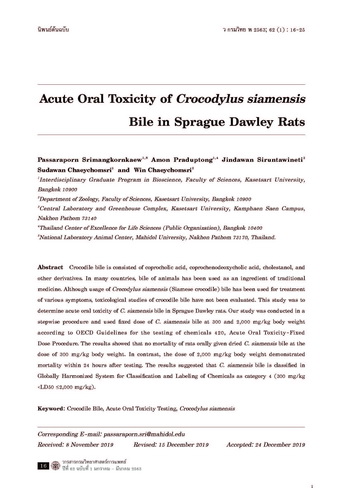การทดสอบความเป็นพิษเฉียบพลันของน้ำดีจระเข้ (Crocodylus siamensis) ในหนูแรท สายพันธุ์ Sprague Dawley
คำสำคัญ:
น้ำดีจระเข้, การทดสอบความเป็นพิษเฉียบพลัน, Crocodylus siamensisบทคัดย่อ
น้ำดีจระเข้ประกอบด้วย Cholestanol, Coprocholic acid, Coprochenodeoxycholic acid และอนุพันธุ์อื่นๆ ในหลายประเทศนำน้ำดีของสัตว์มาใช้เป็นส่วนผสมในตำหรับยาแผนโบราณ น้ำดีจระเข้สายพันธุ์ไทยถูกใช้ และส่งออกมาเป็นเวลานาน ในขณะที่ยังไม่มีข้อการทดสอบทางพิษวิทยาของน้ำดีจระเข้อย่างเพียงพอ การศึกษานี้ได้ทำการประเมินความเป็นพิษเฉียบพลันทางปากในรูปแบบขนาดคงที่ของน้ำดีจระเข้ในหนูแรทสายพันธุ์ Sprague Dawley ในการทดสอบใช้ขนาดของน้ำดีจระเข้ขนาดคงที่ที่ 300 และ 2,000 มิลลิกรัมต่อกิโลกรัมของน้ำหนักตัวสัตว์ทดลอง ตามวิธีการมาตรฐาน OECD Guideline หมายเลข 420 ผลการทดสอบพบว่า น้ำดีจระเข้ที่ขนาด 300 มิลลิกรัมต่อกิโลกรัมของน้ำหนักตัวสัตว์ทดลองไม่ก่อให้เกิดความเป็นพิษ และการตายในสัตว์ทดลอง แต่น้ำดีจระเข้ที่ขนาด 2,000 มิลลิกรัมต่อกิโลกรัมของน้ำหนักตัวสัตว์ทดลอง ทำให้สัตว์ทดลองตายภายใน 24 ชั่วโมงหลังการได้รับสารทดสอบ ผลการศึกษาแสดงให้เห็นว่า น้ำดีจระเข้สายพันธุ์ไทยจัดอยู่ในระบบการจัดกลุ่มสารเคมี การติดฉลาก และการแสดงรายละเอียดบนเอกสารข้อมูลความปลอดภัยสากลหมวดที่ 4 และอาจกล่าวได้ว่ามี LD50 ที่ >300 และ ≤2,000 มิลลิกรัมต่อกิโลกรัมของน้ำหนักตัวสัตว์ทดลอง
เอกสารอ้างอิง
Pharmacopoeia Commission of PRC. Pharmacopoeia of the People's Republic of China. Beijing, China: Chemical Industry Press; 1997.
U.S. National Library of Medicine. Murideoxycholic acid. [online]. 2006; [cited 2018 Dec 6]; [14 screens]. Available from: URL: https://pubchem.ncbi.nlm.nih.gov/compound/Murideoxycholic-acid.
Human Metabolome Database. Showing metabocard for Coprocholic acid (HMDB0000601). [online]. 2005; [cited 2018 Nov 26]; [12 screens]. Available from: URL: https://www.hmdb.ca/metabolites/HMDB0000601.
Picheinsutthorn C, Jeerawong V. Animal medicinal materials. In: Hand out of Thai medicinal pharmacy Vol. III. Bangkok: Amarin Press; 2003. p. 150-167.
Organisation for Economic Co-operation and Development (OECD). OECD guidelines for testing of chemicals No. 420: acute oral toxicity-fixed dose procedure. [online]. 2001; [cited 2019 Oct 20]; [14 screens]. Available from: URL: https://ntp.niehs.nih.gov/iccvam/suppdocs/feddocs/oecd/oecd_gl420.pdf.
Chaeychomsri W, Siruntawineti J, Osotsila I. Process suitable for the preservation of crocodile gall bladder for adding value to product. In: Proceeding of the 35th congress on science and technology of Thailand; 2009 Oct 15-17; Chonburi, Thailand. Bangkok, Thailand: The Science Society of Thailand Under the Patronage of His Majesty the King; 2009. p.569-576.
Chaeychomsri W, Siruntawineti J. Process for preparation of crocodile blood powder and its product, Thai Petty Patent No. 5074. Bangkok, Thailand: Kasetsart University; 2006.
National Research Council. Guide for the care and use of laboratory animals. 8th ed. Washington, DC: The National Academies Press; 2011.
Institutional Animal Care and Use Committee. Guidelines for euthanasia of rodent fetuses and neonates. [online]. 2013; [cited 2019 Jun 18]; [3 screens]. Available from: URL: https://oacu.oir.nih.gov/sites/default/files/uploads/arac-guidelines/b4_rodent_euthanasia_pup.pdf.
Srimangkornkaew P, Praduptong A, Siruntawineti J, Chaeychomsri S, Chaeychomsri W. The evaluation of acute oral toxicity testing of siamese crocodile (Crocodylus siamensis) bile in Sprague Dawley rats in compliance with OECD guideline 423. Biosci Discov 2018; 9(4): 469-73.
Navarro VJ, Khan I, Bjornsson E, Seeff LB, Serrano J, Hoofnagle JH. Liver injury from herbal and dietary supplements. Hepatology 2017; 65(1): 363-73.
Lin DL, Chang HC, Chen CY. Identification and quantitation of bile acids in bear bile by HPLC. J Food Drug Anal 2000; 8(4): 283-88.
Dharmananda S. The medicinal use of snakes in China. [online]. 1997; [cited 2019 Jun 18]; [3 screens]. Available from: URL: https://www.itmonline.org/arts/snakes.htm.
Yeh YH, Wang DY, Liau MY, Wu ML, Deng JF, Noguchi T, et al. Bile acid composition in snake bile juice and toxicity of snake bile acids to rats. Comp Biochem Physiol C Toxicol Pharmacol 2003; 136(3): 277-84.
Wang DQ, Carey MC. Therapeutic uses of animal biles in traditional Chinese medicine: an ethnopharmacological, biophysical chemical and medicinal review. World J Gastroenterol 2014; 20(29): 9952-75.
Yeh YH, Hwang DF. High-performance liquid chromatographic determination for bile components in fish, chicken and duck. J Chromatogr B Biomed Sci Appl 2001; 751(1): 1-8.
Claassen V. Food and water intake. In: Neglected factors in pharmacology and neuroscience research, Vol 12. msterdam: Elsevier; 1994. p. 267-287.
U.S. Environmental Protection Agency (EPA). Chemical hazard classification and labeling: comparison of OPP
equirements and the GHS. [online]. 2004; [cited 2019 Jun 18]; [22 screens]. Available from: URL: https://www.epa.gov/sites/production/files/2015-09/documents/ghscriteria-summary.pdf




